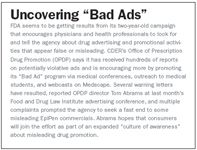Budgets, Biosimilars, and Bad Ads
While the nation was embroiled in the presidential elections, a number of important legal and regulatory issues absorbed pharmaceutical executives, writes Jill Wechsler.
While the nation was embroiled in this year's presidential elections and heated debate over the impact of health reform, a number of important legal and regulatory issues absorbed pharmaceutical executives. One bit of good news was Congressional approval of legislation that stiffens penalties for crimes involving theft and hijacking of drugs and medical devices. Just before leaving town in September, the Senate quietly enacted the Safe Doses Act (HR 4223), which had been approved by the House in June, and President Obama signed the bill into law last month. Manufacturers have long complained that criminals face stiffer penalties for stealing handbags and CDs than prescription drugs. The legislation, which was sponsored by Rep. James Sensenbrenner (R-Wis) and Sen. Charles Schumer (D-NY), changes that by imposing hefty fines and jail sentences for falsification, alteration or forgery of medical products and their subsequent transportation or sale.

Jill Wechsler
Meanwhile, FDA stepped up its campaign against illegal Internet drug sales, joining the fifth "Operation Pangea" coordinated by Interpol. The recent effort shut down more than 18,000 pharmacy websites worldwide and led to the seizure of about $10 million worth of drugs. In the United States FDA took action against some 4,000 Internet pharmacies, sending out warning letters, seizing illegal products, and shutting websites—at least temporarily. At the September meeting of the Partnership for Safe Medicines, commissioner Margaret Hamburg also described FDA's "BeSafeRx" campaign, which aims to educate consumers on the dangers of Internet drug purchases.
All this took place amidst a mounting national outcry over a meningitis outbreak linked to contaminated injectables from a Massachusetts compounding pharmacy. The health crisis focused attention on FDA's limited authority to regulate these operators and generated calls for legislation to remedy the problem, a move supported by both parties.
During the Congressional recess, discussions continued over legislative proposals for establishing a national drug track-and-trace system. Manufacturers and FDA officials still hope to devise a workable program for monitoring drugs through the supply chain, but have been stuck over whether to start with a more limited batch-level tracking approach, versus the feasibility of requiring tracking for every vial, as FDA prefers.
The prospect of across-the-board federal budget "sequestration" to reduce the projected $1.2 trillion budget deficit began to generate "savings" proposals from interest groups on all sides. The Pharmaceutical Care Management Association (PCMA), which represents pharmacy benefit managers (PBMs), weighed in last month with its list for cutting federal spending on prescription drugs by $100 billion over 10 years. PCMA urges more generic drug use by Medicaid and Medicare Part D drug plans, expanded mail order services for home-bound elderly patients, and an end to Part D "protected drug classes" to permit broader price negotiations. The PBMs also want to drop tax deductions for direct-to-consumer drug advertising to make it harder for brand manufacturers to drive consumer use of their more expensive products.
Boosting biosimilars
Another PCMA idea is to speed new "biogenerics" to market by reducing the 12-year exclusivity for innovator biologics and accelerating FDA efforts to establish an approval pathway for biosimilars. Here FDA officials are hard at work mapping out an innovative "weight of evidence" approach for testing and developing biosimilar products. It relies on extensive comparative analysis and functional studies upfront to shape the size and scope of further testing, a policy that represents "a paradigm shift" in how FDA documents drug safety and efficacy, observed Janet Woodcock, director of the Center for Drug Evaluation and Research (CDER), at a Drug Information Association (DIA) September conference.

Uncovering "Bad Ads"
FDA laid out this concept for biosimilar development in three draft guidances published in February 2012, and a CDER/CBER biosimilar implementation committee is weighing comments and further changes. Meanwhile, manufacturers are seeking advice from FDA about biosimilar development options, as seen, as of early October, in 47 requests for pre-IND meetings on proposed biosimilars to 11 reference products. Agency staffers have held 30 meetings, and 12 INDs have been filed for possible biosimilars, some involving new development programs and some building on data from products already licensed in Europe. Biosimilar review committees in the agency's centers for drugs and biologics are vetting sponsor queries and agency answers to ensure that staff advice is consistent across divisions.
Despite all the discussion, FDA still awaits its first official 351(k) biosimilar application, as authorized by the Biologics Price Competition and Innovation Act (BPCI) in the Affordable Care Act of 2010. Teva Pharmaceuticals recently received FDA approval of its version of Amgen's Neupogen (filgrastim), but opted for a biological license application (BLA) instead of taking the new route. This approach gives Teva 12-years of exclusivity for its product and avoids the complex and untested patent dispute resolution process established by BPCI.
In addition to technical and scientific challenges, a number of legal and regulatory issues will shape the development path for a new biosimilar. Besides the convoluted process for addressing exclusivity and patent rights, there is considerable debate over biosimilar names and product codes, which are key to market acceptance of the new products. The size and shape of clinical studies remains uncertain, along with questions about non-US comparators and bridging studies. Interchangeability is still the ultimate goal for most biosimilar makers, but such a designation may require more extensive test data. All sides anticipate lawsuits and citizens' petitions that will take years to resolve, in addition to other controversies.
Despite these uncertainties, the first step for manufacturers is to develop a clear analytical plan for demonstrating biosimilarity of a follow-on to a reference product, advised Steve Kozlowski, director of CDER's Office of Biotechnology Products (OBP). He observed that manufacturing and product analysis are usually at the "low end of the totem pole" in drug development, but for biosimilars, structural and functional characterization provides a foundation for determining the scope of pre-clinical and clinical studies. Advances in manufacturing science, moreover, may support comparative assessment using a fingerprint-like analysis or "super characterization" approach.
FDA is trying to be flexible, Kozlowski emphasized, noting that different formulations and alternative delivery devices or container closure systems may be acceptable. While FDA expects that sponsors will have to conduct at least one immunogenicity study, Koslowski says that "the door is open," to the concept that "added studies may not be necessary."
Jill Wechsler is Pharmaceutical Executive's Washington correspondent. She can be reached at jwechsler@advanstar.com.

Navigating Distrust: Pharma in the Age of Social Media
February 18th 2025Ian Baer, Founder and CEO of Sooth, discusses how the growing distrust in social media will impact industry marketing strategies and the relationships between pharmaceutical companies and the patients they aim to serve. He also explains dark social, how to combat misinformation, closing the trust gap, and more.
Talphera Cuts NEPHRO CRRT Study Size, Secures $14.8 Million Private Placement
April 1st 2025The trial size adjustment, along with protocol modifications and the addition of higher-enrollment sites, is expected to facilitate completion of the NEPHRO CRRT study of Niyad in patients undergoing renal replacement therapy by the end of 2025.




















